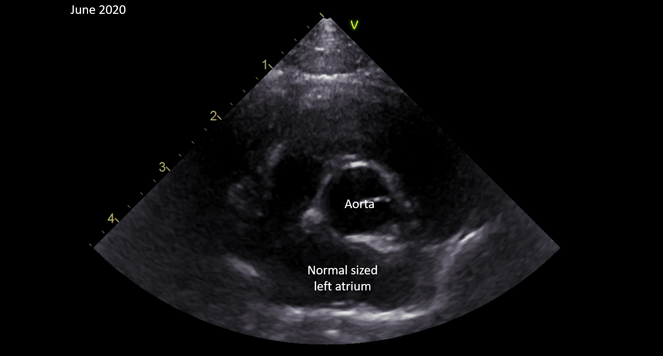The following morning, we received results of the blood tests that we had submitted to our on-site laboratory. These tests showed that he had a very high troponin I. Although the majority of cats with a heart that looks like Gordon’s have a primary heart problem called hypertrophic cardiomyopathy (HCM), his young age and high troponin raised the possibility of a rare condition called “transient myocardial thickening.” This is a recently identified condition in cats, about which little is known. However, affected cats seem to have recently experienced a stressful event in many cases. Although HCM and transient myocardial thickening look very similar at first, they have very different outcomes. Cats with HCM have disease progression over time, and those with congestive heart failure signs sadly tend to survive for only around 1 year. Importantly, cats with transient myocardial thickening return to normal over a few weeks or months. They tend to have a very good prognosis, usually not requiring long-term treatment.



Gordon initially responded well to treatment for congestive heart failure but on his second day in the hospital he acutely developed an arterial thromboembolism and his breathing worsened. Our ICU team were able to intervene quickly and, to save his life, Gordon was anaesthetised and mechanically ventilated. He also received an infusion of tissue plasminogen activator to rapidly break down the blood clot to his leg. Twenty-four hours later, Gordon was doing well, so he was woken up and taken off the ventilator. His breathing and use of his legs remained normal. A couple of days later, he was moved from our intensive care unit to our dedicated feline ward to continue his recovery before being discharged from the hospital.
Gordon returned to see us for check-ups in February, April and June. Over this time, we have documented his heart size and function improving. At his most recent check-up his, the heart scan was considered normal, which diagnosed him with transient myocardial thickening. Despite everything Gordon has been through, he no longer needs to take any medication, and his owner has told us that he continues to do well at home. Gordon’s journey back to normal required a lot of input from multiple departments, including cardiology, feline medicine, emergency and critical care and anaesthesia. This is one of the huge benefits to our large, multi-disciplinary hospital team. We are able to provide excellent patient care, no matter how unusual the condition. We hope that Gordon and his family continue to enjoy many more years together!





